To even be likened to Erling Haaland, you need to be truly special. But that is what is happening to 20-year-old Rasmus Hojlund.
Manchester United are heavily linked with the young Dane and Erik ten Hag has made it clear that signing a centre-forward is a priority this summer.
- But how fair are comparisons between the two players?
Haaland combines pace, power and physicality like few ever have in world football. He’s 6-foot-5 but explosively quick and deceptively delicate when he needs to be. By no means is the Manchester City No. 9 your stereotypical big man centre-forward who relies on his height and physique.
Since bursting onto the scene with Molde, Haaland has scored goals for Red Bull Salzburg, Borussia Dortmund and Manchester City. Nothing seems to faze him. He once scored nine goals in a single U20 game for Norway and his record for the senior team is 24 goals in 25 appearances.
Across Man City’s treble-winning campaign, he scored 52 goals in all competitions and he netted 41 for Borussia Dortmund during his first full season with the club.
As such, there’s little wonder why there continues to be a scramble for the next Haaland.
Finding that player is of course easier said than done.
And yet the feeling is Atalanta may have done exactly that.
At first glance, the similarities between Haaland and Rasmus Hojlund are fairly obvious. The Scandinavian duo have long blonde hair, both are over six foot tall, possess a cannon of a left foot and share a brutish quality in the final third.
In a recent interview, Atalanta manager Gian Piero Gasperini compared his summer signing with the Manchester City goal machine:
Hojlund has this spirit, energy, intensity, but also the technical quality that is just remarkable. He still has so much margin for improvement, too.
He has very similar characteristics to Haaland. He is so quick, he’s under 11 seconds over 100m and that’s not even trying very hard. Considering his height, he has a low centre of gravity. I am convinced he’ll have a great career, he just gets stronger every day.
- Lofty praise indeed. But let’s rewind a little.
Hojlund moved to Atalanta’s Gewiss Stadium last summer in a deal believed to be in the region of £15 million. The transfer came just seven months after Sturm Graz parted with £1.5m to bring him to the Austrian Bundesliga from Copenhagen.
The 20-year-old had failed to score a single league goal for the Danish side prior to his move to Austria but the switch seemed to reinvigorate his fledgling career.
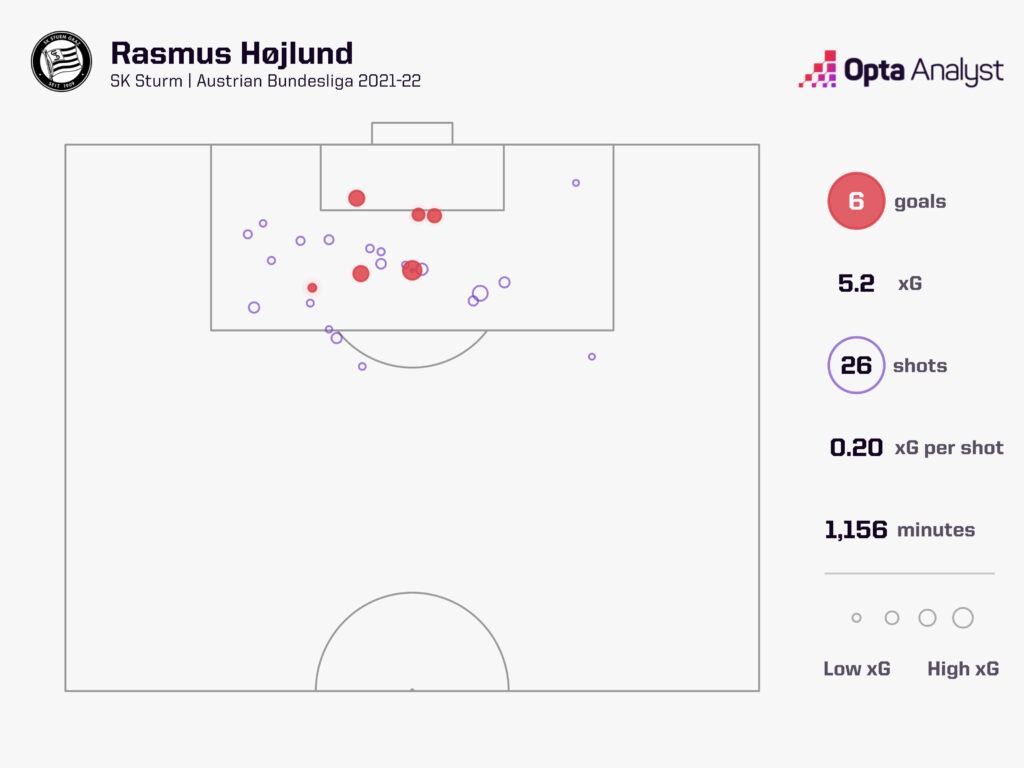
In 2021-22, the centre-forward scored six times in 1,156 minutes from an expected goals haul of 5.2 to help fire Sturm Graz into second position behind Red Bull Salzburg. Even from his modest amount of playing time, there were signs that Hojlund possessed the instincts and intelligence needed to get into high-value goalscoring areas. His shot map above shows a cluster of strikes from inside the penalty area and only eight other players could boast a better xG per shot average than his 0.20 over the course of the season. Those underlying numbers suggest Hojlund would be expected to score with one in every five attempts, reiterating the fact he is a genuine, reliable goal threat.
An example of this in practice can be seen below.
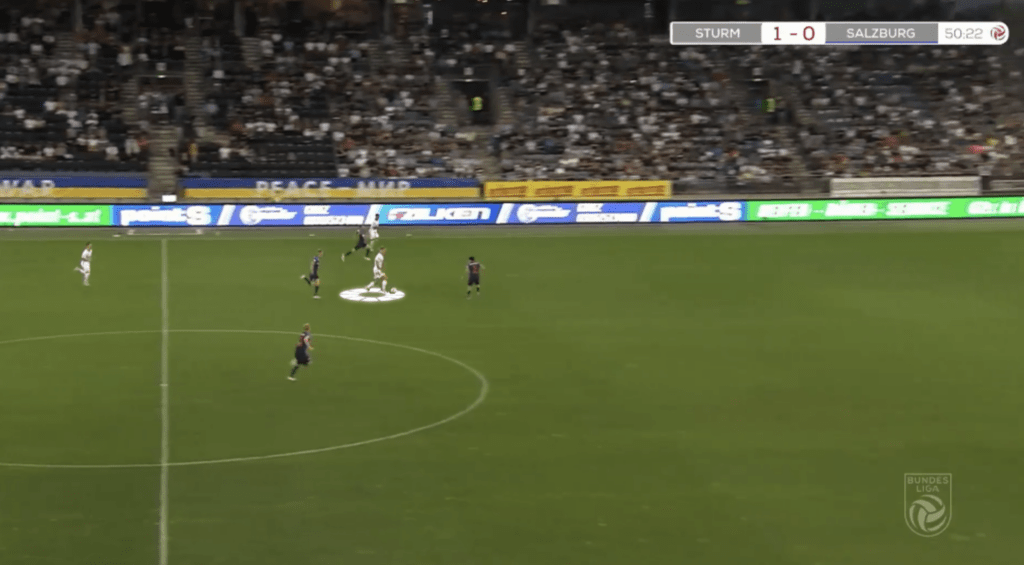
Hojlund picks the ball up just inside the opposition’s half. He has a teammate to his left and just one player between him and the goalkeeper, though there is still a lot of ground to make up.
In this situation, a number of players would look to pass to the man on the left before attacking the penalty area centrally in the hope the ball is played across the box for an easy finish.
The Danish international ignores this option and instead knocks the ball past the defender and just breezes past him.
He races clear of those looking to get back at him before taking an extra touch to set himself. Then, before the keeper can further close down the angle, Hojlund calmly strokes the ball into the net with his effort kissing the underside of the bar.
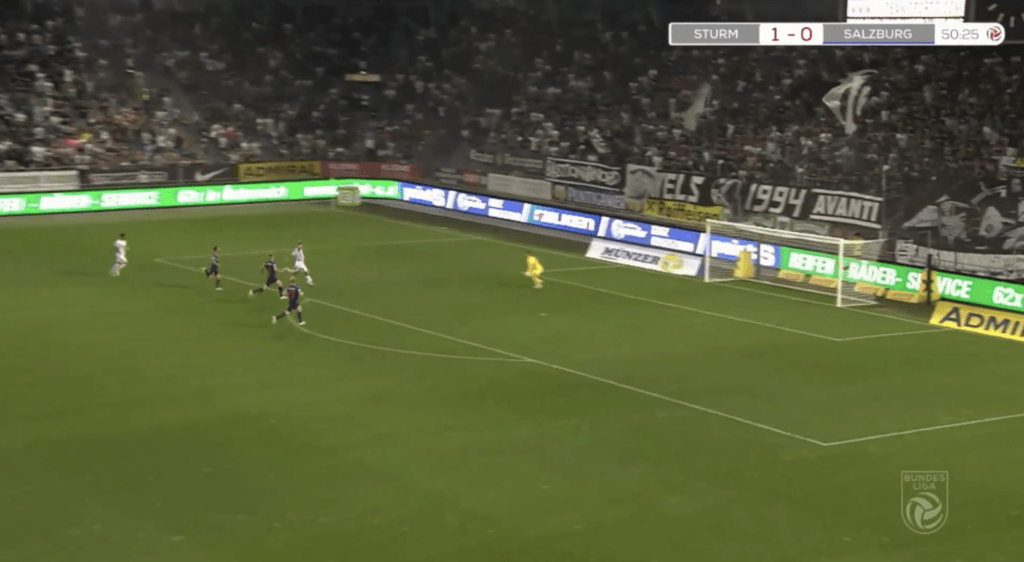
It was an empathic finish and one that he made look easy when it was anything but.
Aside from his obvious speed, one thing to highlight in this example is how he takes an extra touch to get the ball into the penalty area. It sounds simple but even the most experienced strikers can get flustered when bearing down on goal and it can lead them to rushing an effort from outside of the box.
The fact Hojlund has the presence of mind to take the touch forces the keeper to engage with him and it is during this movement that the striker shoots. So, he’s closer to the goal, the keeper isn’t set and the strike itself is audacious yet unnerving.
Everything he does during this phase of play is geared towards increasing the likelihood of him scoring.
Sounds like Haaland in a nutshell, right?
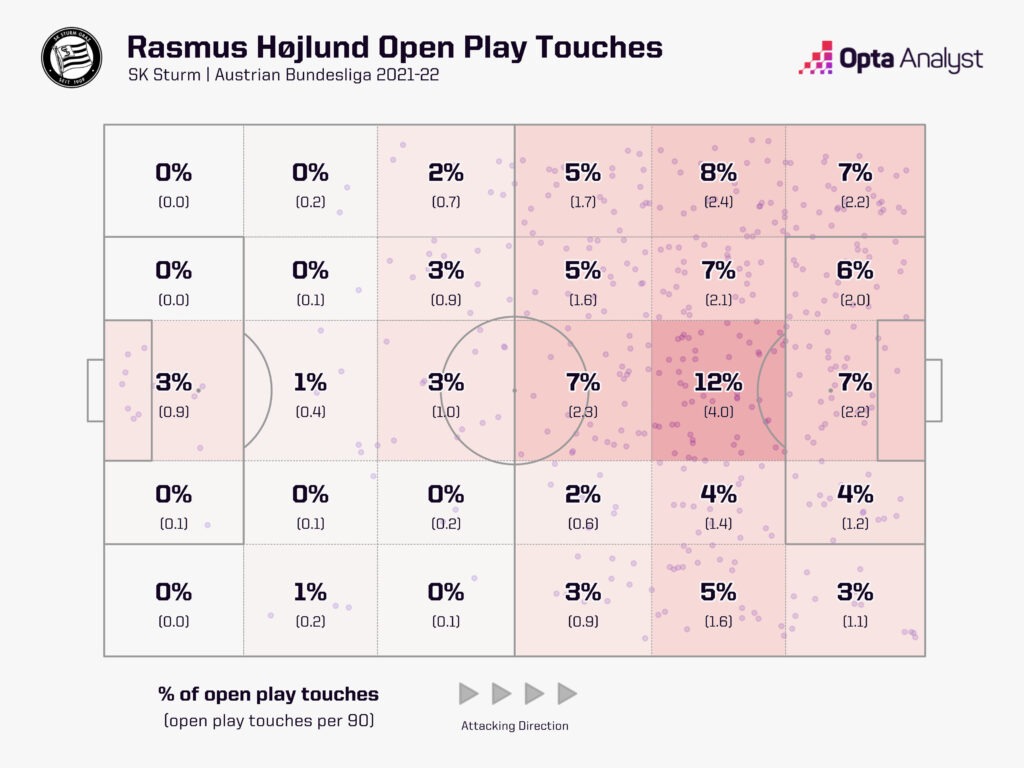
Another Haaland trait of Hojlund’s game is his desire to be in central areas. A lot of strikers nowadays will drift into wider areas to find space. They do everything but stay in the middle of the pitch.
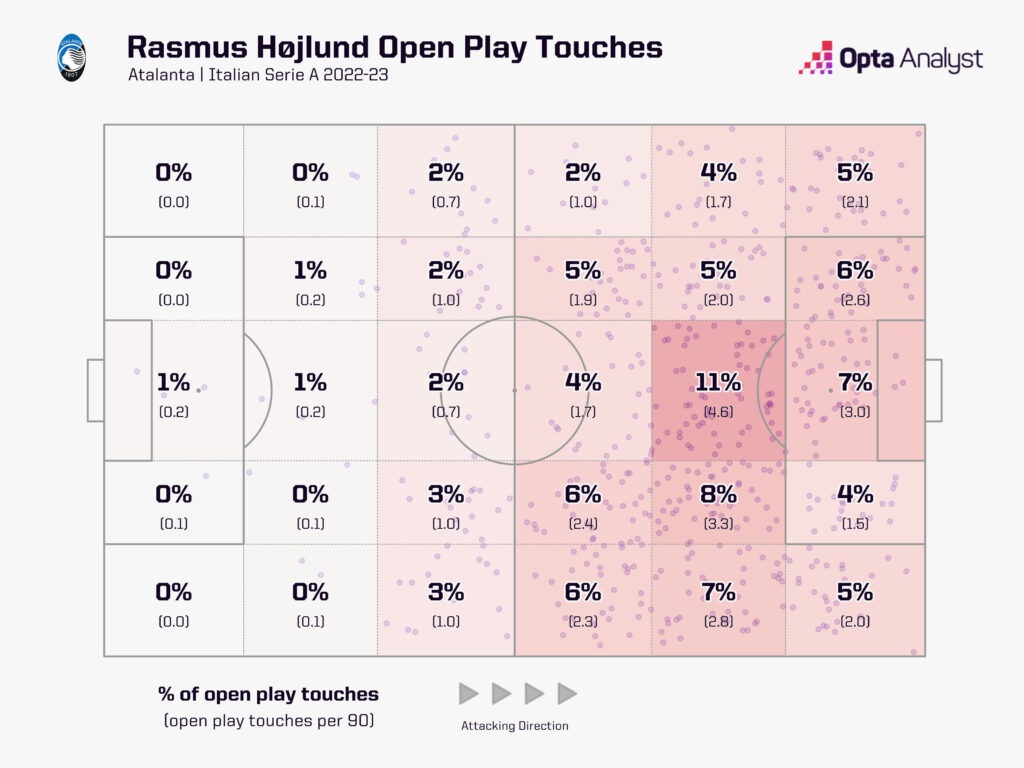
Despite playing in a variety of systems for Atalanta, he still gets on the ball in central areas, just as he did at Sturm Graz. In fact, when you compare his touch maps across the two sides, they are remarkably similar.
His shot map and underlying numbers are very similar too, suggesting that Hojlund has been able to translate his game exceptionally well despite moving to a more difficult league.
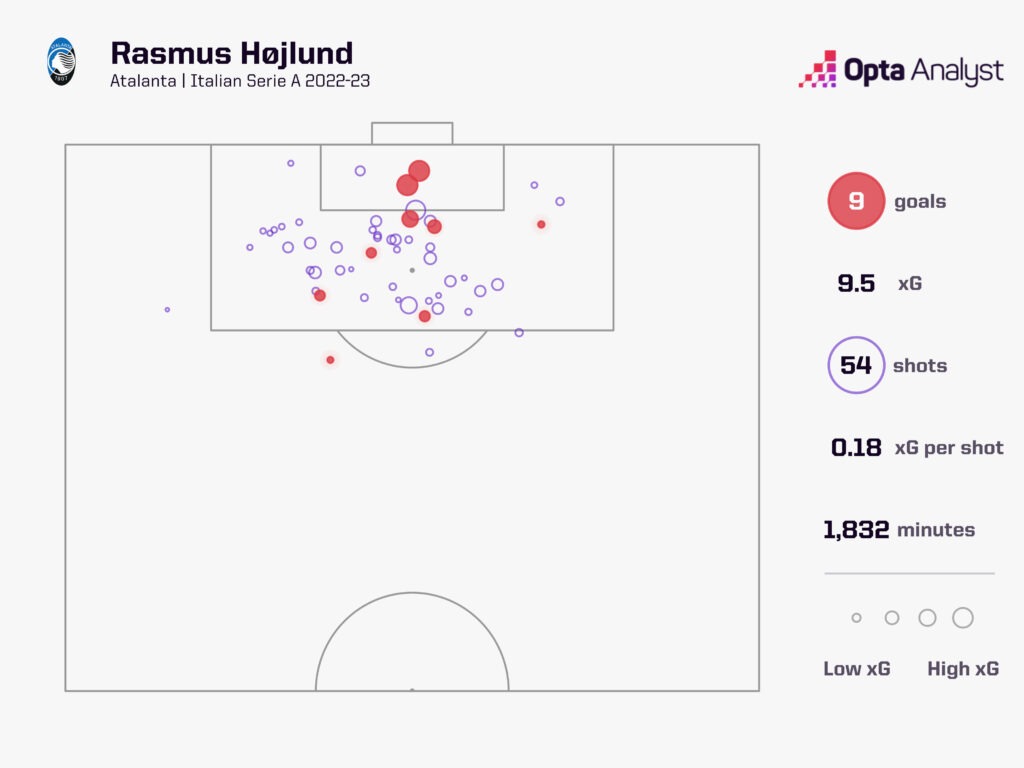
Across 1,832 minutes in Serie A this term, Hojlund scored nine goals from an xG of 9.5 His xG per shot average is 0.18, almost identical to what he posted for Sturm Graz. Hojlund took just three shots from outside of the penalty area in Serie A this season, and even those were within two yards of the box.
He isn’t one to waste possession with low-value shots. Instead, he’s always looking to get into better positions.
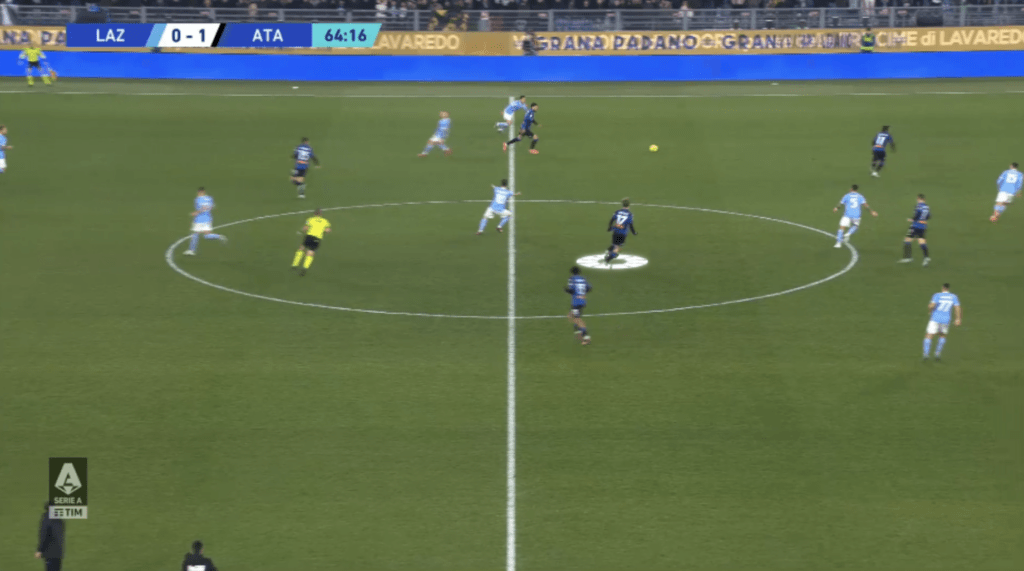
Having dropped off to compete for a loose ball, Hojlund is fairly deep when Atalanta regain possession. Teun Koopmeiners is ahead of him, and the Dutchman could attack the box as the play progresses. But as soon as the ball is played out wide, Hojlund powers through the middle of the pitch to get back into a centre-forward position.
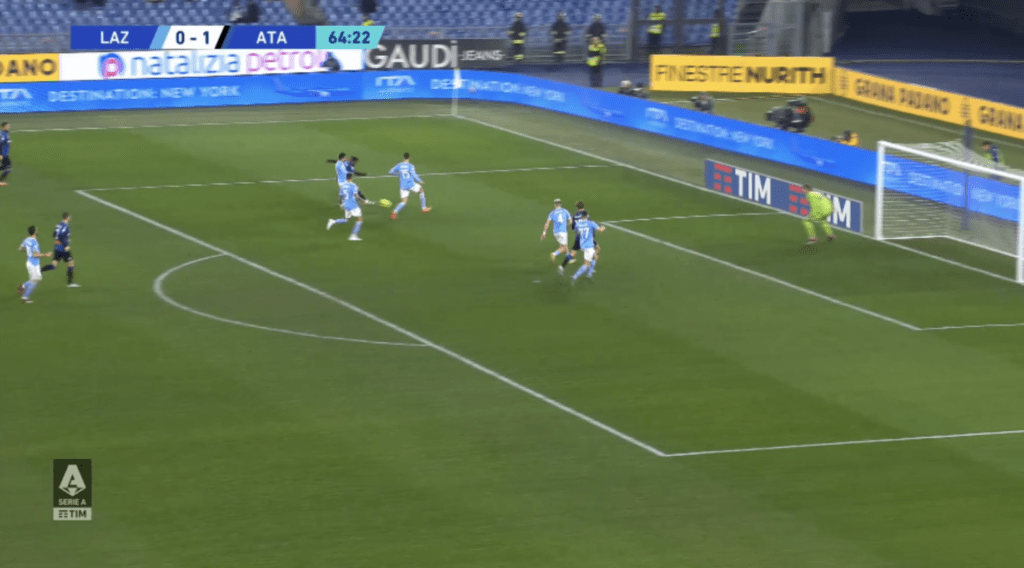
He then finishes off the move by poking the ball into the net from about five yards out.
The desire to score gets him into that position. The Dane could’ve lingered on the edge of the box, waiting for a cutback, but instead he wanted to ensure his shot was a high-value chance if the ball did reach him.
That work rate alone is worth a number of decent chances per season. Haaland is exactly the same too, which is why so many of his goals appear to be easy tap-ins.
But while there are plenty of similarities between the two, both physically and stylistically, there are also differences. Some of these could be tied to their roles within the system but some will just be to do with them as a player.
For example, Hojlund isn’t yet as much of a volume monster. Across his time with Sturm Graz and Atalanta, he’s averaged just 2.4 shots per 90 and he has an xG per 90 of 0.41. By comparison, Haaland has averaged 3.8 shots per 90 across his time with Red Bull Salzburg, BVB and the Premier League champions and he’s posted an xG per 90 average of 0.90, and the trend for Haaland’s shots per game is increasing year on year. Being compared to Haaland from a volume perspective is always going to be a hiding to nothing though, and Hojlund’s xG per 90 in 2022-23 of 0.47 is very respectable in Serie A. Just 10 players can boast a better tally.
The spread of shots is interesting though, with Hojlund (24% of shots) showing a slightly higher tendency to take headed shots compared to Haaland’s 22%. Hojlund is also a lot more open to using his weaker foot, too, with close to 25% of his efforts coming via his right foot. By comparison, just 15% of Haaland’s attempts have been with his right.
Given the age of both strikers these are obviously small sample sizes, but they are subtle yet important differences. Because while the Atalanta man isn’t as lethal as Haaland, his variety of shot selection shows there are potentially several ways in which he can hurt you. Unpredictability in the penalty area is a useful trait to have, especially as a goalscorer, and Hojlund has it.
The forward made headlines across the international break earlier this year for his performances for Denmark, netting fives times in two games – including a hat-trick against Finland – to sit top of the Euro 2024 qualifying scoring charts.
The interest in the 20-year-old is understandable. He’s still raw in certain areas – his link-up play in particular needs refinement – but regular minutes will see him improve.
In Hojlund, there’s a player who possesses intelligent movement, power, pace and an aptitude to score a variety of goals. He could soon follow Haaland to the Premier League and, if deployed in the right system, the left-footed goalscorer could have a similar impact on the English top flight.
